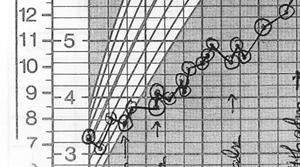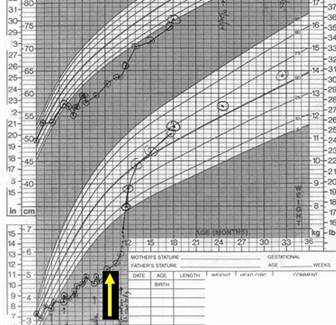Case Study #4
Carefully prepared pediatric growth charts are often the key to the diagnosis of child neglect, as indicated in this case study.
You are covering for a primary care pediatrician, who is on vacation. You receive a call from the family of an 11-month child, whom the pediatrician had been followed since birth for poor weight gain, who reports the child is feverish and spitting up more than usual.
When you examine the child, you notice that the child is well below the 5th percentile for both weight and height, has severely delayed motor development, and has generalized poor muscle tone.
You review the child's medical records and find that she has been hospitalized three times (Fig. 47, small arrows) and obtained numerous subspecialty consultations for her failure to gain weight. No medical explanation for her growth failure has ever been found, and one subspecialist suggested the possibility that she is being starved. You do not find any indication a report has ever been made to Child Protective Services.
You note that each time she was hospitalized, she gained weight rapidly, only to lose weight after discharge.

Fig. 44: Closeup of the weight section of the growth chart of the child in Case Study #44. Small arrows indicate hospital admissions for failure to gain weight.
Do you have any reason to suspect the child is the victim of child neglect by starvation? Explain your answer.
Which steps should you take at this point?
There are at least two reasons to suspect nutritional neglect: the lack of a medical diagnosis after extensive evaluations, and the documented good weight gain in hospital settings.
Fig. 45: Denouement to Case Study #4. The child was admitted for a fourth time (yellow arrow). Child Protective Services took custody of the child and placed her in a caring foster home. Note the dramatic recovery in weight over the next 2 months, with substantial recovery in length as well.